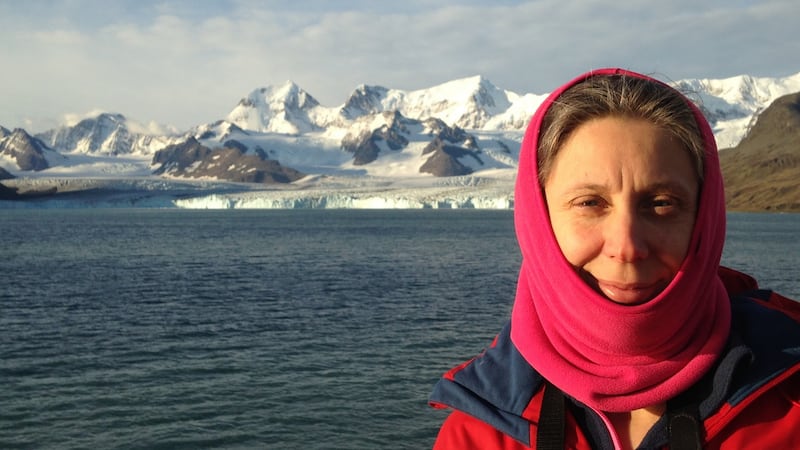When American scientists accidentally filmed a marine being they nicknamed Casper during research off Hawaii earlier this year, one of the first experts they contacted was NUI Galway’s Dr Louise Allcock.
They sent her images of the octopod, with its ghostly lilac glow, which had been perched on a flat area of rock 4,290m deep when the remotely operated vehicle approached it.
The scientists on board the research ship Okeanos Explorer were taken aback. Some of the eight-armed cephalopod molluscs in the octopoda order have been recorded at depths below 5,000m, but this particular type – an incirrate, lacking fins and the "cirri" associated with suckers on arms – had not.


“This animal was particularly unusual because it lacked the pigment cells, called chromatophores, typical of most cephalopods, and it did not seem very muscular,” writes Michael Vecchione of the US National Oceanic and Atmospheric Administration on his blog. “This resulted in a ghostlike appearance, leading to a comment on social media that it should be called Casper, like the friendly cartoon ghost.” He added that it is “almost certainly an undescribed species and may not belong to any described genus”.
Allcock was on another research ship in the far colder waters of the Antarctic when she heard from the Okeanos Explorer team. She was able to confirm that Casper had set a depth record for incirrates.
“As exploration has gone deeper with cameras, more records have surfaced, and these have often been directed towards me,” Allcock says. “Casper is from deeper than any published records, so it was pretty exciting. It’s probably a new genus of octopus.”
Allcock, from NUIG's School of Natural Sciences, had been invited on the British Antarctic Survey expedition for several reasons, including her expertise on octopods and deep-sea ecology.
A big name in the field
Allcock’s name is likely to crop up in conversations about research of spooky creatures of the deep. Three years ago, a research team she led to the Whittard Canyon southwest of Ireland found a rare giant hydroid, a deepwater rough shark and 200-year-old clams and oysters. The hydroid, which is said to use its tentacles to catch fish, belongs to a taxonomic group related to corals and jellyfish and thrives on sandy seafloors with a good current in deep water.
The remit of the expedition on the RSS James Clark Ross was to survey the world's first protected marine area in the high seas, established in 2009 on the South Orkney islands southern shelf in the Southern Ocean. The area has considerably biodiversity, and more than 700 photographs of seafloor habitats and nearly 4,000 photos of live animals were taken during the month-long expedition. Some 18 phyla of animals were found in depths of 500m-2,000m.
Scientific highlights recorded by the research team included the discovery of new species, and some rare animals such as pelagic sea mosses (which are animals, despite their name, Allcock points out). They also found a "graveyard" of the plates of long-dead giant barnacles, and vulnerable species such as corals, sponges and pencil urchins were evident throughout.
“We saw a beautiful field of solitary hydroids in some deep, softish substrate, feeding on marine snow,” she says. Marine snow is biological debris that falls from higher in the water column.
Allcock says there is a clear correlation between the presence of these so-called “vulnerable marine ecosystem indicator species” and overall biodiversity.
The lack of fishing activity in the area makes the research particularly valuable, she says. “There is a methodology related to longline by-catch, and we are trying to devise better and less invasive ways of monitoring sensitive areas,” she says.
Deep-sea life habitats tend to have more similarities than differences across the planet compared with shallow-water areas, and this is partly due to the influence of glaciation cycles every 40,000 years or so.
In between the ice sheets are pockets of open ocean, called polynyas, she explains. These small pockets of life tend to gain their own slightly different characteristics, and might no longer be able to interbreed by the time the ice melts.
“Discovering more about these ecosystems is fundamental in making sure these beautiful complex habitats are protected,” she says. And it also ties into biodiscovery, such as finding marine organisms that might contain antibacterial and other pharmaceutical properties.
DEEP RESEARCH: SURVEYING THE UNKNOWN SEAFLOOR
There are "striking similarities between deep Antarctic habitats and deep-sea habitats in Irish waters", says NUI Galway's Dr Louise Allcock.
Ireland has some of the most extensive deep-sea environment in Europe, with 43 canyon systems on the Continental margin. The Whittard is huge: twice the depth of the US Grand Canyon.
She believes there is probably far more deepwater coral, some of it already protected, than has already been documented in the Irish margin. Although some of it could be vulnerable to human activity – including fishing, and oil and gas exploration – much of it is in areas difficult to trawl, she notes.
Ireland's national research vessel, the RV Celtic Explorer set sail from May 11th to 21st to map some 12,000km2 of unsurveyed seafloor from the deepest areas of the Atlantic Ocean as part of an international expedition with Canada and the US.
Student researchers were among the complement on board, having qualified for a bursary known as the Atlantic Seabed Mapping scholarship as part of Ireland’s national seabed-mapping programme, Infomar.
This is the fourth seabed mapping survey to take place under the Atlantic Ocean Research Alliance. Xavier Monteys of the Geological Survey of Ireland led a team of 12 international scientists, who mapped a transect of the Atlantic seafloor between St John’s in Newfoundland and Galway.
- The expedition's details can be followed on atlanticresource.org/aora/trasna










